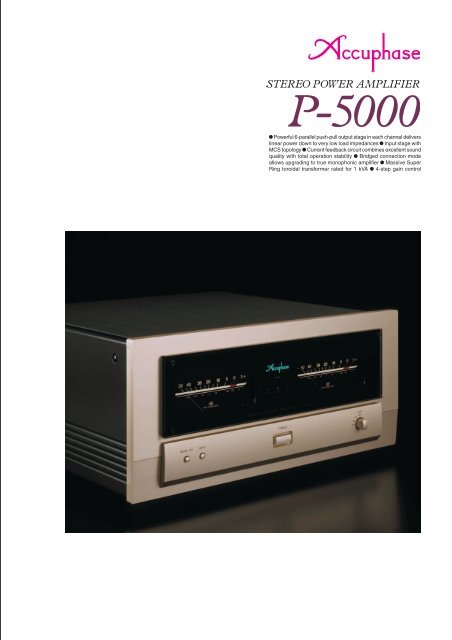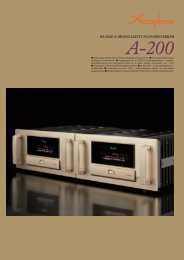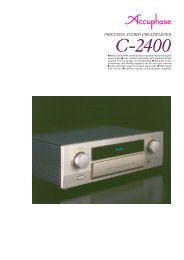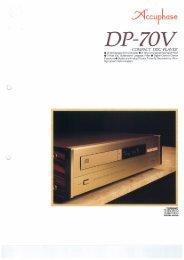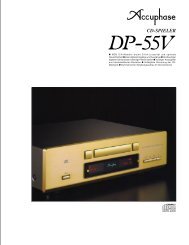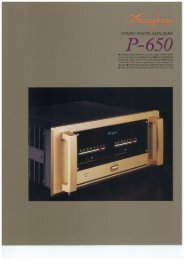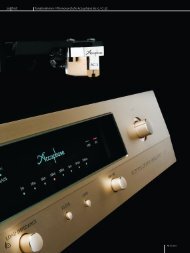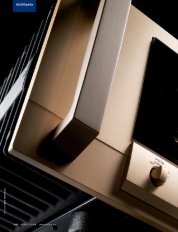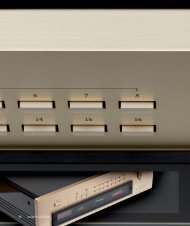You also want an ePaper? Increase the reach of your titles
YUMPU automatically turns print PDFs into web optimized ePapers that Google loves.
m Powerful 6-parallel push-pull output stage in each channel delivers<br />
linear power down to very low load impedances m Input stage with<br />
MCS topology m Current feedback circuit combines excellent sound<br />
quality with total operation stability m Bridged connection mode<br />
allows upgrading to true monophonic amplifier m Massive Super<br />
Ring toroidal transformer rated for 1 kVA m 4-step gain control
Stereo power amplifier is ideal match for C-2400 MCS technology in<br />
input stage improves S/N ratio, distortion ratings and other characteristics.<br />
6 pairs of wide-band high-power transistors in parallel push-pull<br />
configuration for each channel. Massive 1 kVA toroidal power transformer<br />
supports 650 watts of power into ultra-low 1-ohm impedance. 4-step gain<br />
control effectively reduces noise.<br />
The P-<strong>5000</strong> continues the distinguished design<br />
policy of the M-8000 and P-7000. This stereo<br />
power amplifier uses carefully selected top<br />
quality parts throughout and is an ideal match<br />
for the C-2400 preamplifier. MCS topology in<br />
the input stage reduces noise even further.<br />
Refined technology and inspired design result<br />
in superb performance and flawless sound<br />
quality.<br />
In order to drive any kind of speaker with<br />
precision and authority, a power amplifier must<br />
provide extremely low output impedance<br />
(Note 1) and be capable of supplying a<br />
constant drive voltage at all times (Note 2). To<br />
realize these design goals, a power supply<br />
that fully meets the demands of the output<br />
stage is necessary. In the output stage of the<br />
P-<strong>5000</strong>, six pairs of high-power transistors with<br />
a rated collector dissipation of 150 watts are<br />
arranged in a parallel push-pull configuration<br />
for each channel. The devices are mounted to<br />
large heat sinks for efficient dissipation of<br />
thermal energy. Rated output power into 1 ohm<br />
is 650 watts per channel (music signals only).<br />
Power remains linear also when impedance<br />
changes, as exemplified by the rating of<br />
400 watts into 2 ohms, 200 watts into 4 ohms<br />
and 100 watts into 8 ohms. Even speakers<br />
with very low impedance or with drastic<br />
impedance fluctuations can be driven<br />
effortlessly and accurately. By using the P-<strong>5000</strong><br />
in bridged mode, it is possible to create a<br />
monophonic amplifier with even higher power<br />
reserves. This performance is sustained by a<br />
massive high-efficiency Super Ring toroidal<br />
transformer and large filtering capacitors.<br />
The important input stage also has been given<br />
due attention. Another <strong>Accuphase</strong> innovation<br />
called MCS (Multiple Circuit Summing) helps<br />
to minimize noise. Current feedback topology<br />
assures totally stable operation up to very high<br />
frequencies. Balanced inputs shut out external<br />
noise. The copper foil side of the PCBs and all<br />
input and output terminals and major signal<br />
carrying points are gold plated, for enhanced<br />
signal purity.<br />
BIAS STABILIZER<br />
CIRCUIT<br />
Note 1: Low amplifier output impedance<br />
When forming the load of a power amplifier a loudspeaker<br />
generates a counterelectromotive force that can flow back into<br />
the amplifier via the NF loop. This phenomenon is influenced by<br />
fluctuations in speaker impedance and interferes with the drive<br />
performance of the amplifier. The output impedance of a power<br />
amplifier should therefore be made as low as possible by using<br />
output devices with high current capability. This absorbs the<br />
counterelectromotive force generated by the voice coil and<br />
prevents the occurrence of intermodulation distortion.<br />
Note 2: Constant drive voltage principle<br />
Even when the impedance of a load fluctuates drastically, the<br />
ideal power amplifier should deliver a constant voltage signal to<br />
the load. Figure 2 is a graph plotting the output voltage versus<br />
current characteristics. Even when the load changes, the output<br />
voltage remains almost constant, showing linear current<br />
progression. Actual measurement of clipping power at the<br />
extremely low load impedance of 1 ohm yields 660 watts. At 2<br />
ohms, the figure is 500 watts, at 4 ohms 310 watts, and at 8<br />
ohms 171 watts. This demonstrates the impressive performance<br />
reserves of this amplifier.<br />
6-parallel push-pull power unit delivers guaranteed<br />
linear power output of 400 watts into 2 ohms, 200<br />
watts into 4 ohms and 100 watts into 8 ohms<br />
The output stage uses high-power transistors with<br />
a rated collector dissipation of 150 watts and<br />
collector current of 15 amperes. These devices boast<br />
excellent frequency response, current amplification<br />
linearity, and switching characteristics. The<br />
transistors are arranged in a 6-parallel push-pull<br />
configuration (Figure 1) for ultra-low impedance and<br />
mounted on a massive heat sink made from diecast<br />
aluminum. This assures effective heat dissipation<br />
and reduces the impedance of the output stage.<br />
Power linearity is maintained down to ultra-low loads,<br />
which demonstrates the impressive capabilities of<br />
this amplifier.<br />
Output current (A)<br />
Output voltage (V)<br />
* 1-ohm operation possible with<br />
music signals only<br />
Fig. 2 Output power vs. load impedance<br />
(output voltage/output current: actual measurements)<br />
MCS topology in input stage reduces residual noise<br />
and drastically improves S/N ratio<br />
The input stage features <strong>Accuphase</strong>'s original MCS<br />
(Multiple Circuit Summing) design. Three separate<br />
unit amplifiers for the input signal are connected in<br />
parallel, minimizing noise and distortion and greatly<br />
improving other performance parameters as well.<br />
This approach yields further improved sound quality.<br />
NFB switching type gain control<br />
reduces residual noise<br />
BIAS STABILIZER<br />
CIRCUIT<br />
Because the current feedback<br />
type amplifier circuitry is very<br />
stable and introduces little phase<br />
shift, an NFB switching gain<br />
control has become possible<br />
(MAX, –3 dB, –6 dB, –12 dB).<br />
With this approach, reducing gain<br />
also results in reduced noise.<br />
This is especially beneficial when<br />
using highly efficient speaker<br />
systems where the noise floor<br />
could be a problem.<br />
BIAS STABILIZER<br />
CIRCUIT<br />
Fig. 1 Circuit diagram of amplifier section (one channel)
Current feedback circuit topology prevents phase<br />
shifts in high frequency range<br />
The P-<strong>5000</strong> employs the renowned current feedback<br />
principle developed by <strong>Accuphase</strong>. At the sensing<br />
point of the feedback loop, the impedance is<br />
– Input<br />
Buffer<br />
+ Input<br />
Buffer<br />
Current<br />
adder<br />
I-V<br />
converter<br />
Trans-impedance<br />
amplifier<br />
Current NFB<br />
network<br />
Amplifier<br />
Output<br />
Fig. 3 Current feedback amplifier principle diagram<br />
kept low and current detection is performed. An<br />
impedance-converting amplifier then turns the current<br />
into a voltage to be used as the feedback<br />
signal. Since the impedance at the current feedback<br />
point (current<br />
adder in<br />
Figure 3) is<br />
very low, there<br />
is almost no<br />
phase shift.<br />
Fig. 4 Frequency response with current<br />
feedback<br />
Phase compensation<br />
can<br />
be kept to a<br />
minimum, resulting<br />
in excellent<br />
transient response and superb sonic transparency.<br />
Minimal amounts of NFB are used to maximum<br />
effect, providing natural energy response.<br />
Figure 4 shows frequency response for different<br />
gain settings of the current feedback amplifier. The<br />
graphs demonstrate that response remains uniform<br />
over a wide range.<br />
Robust power supply with "Super Ring" toroidal<br />
transformer and high filtering capacity<br />
The P-<strong>5000</strong> features a massive toroidal power transformer<br />
with a maximum rating of 1 kVA. The transformer<br />
is housed in<br />
a non-resonant aluminum<br />
case filled<br />
with a material that<br />
transmits heat and<br />
absorbs vibrations.<br />
This completely prevents<br />
any adverse<br />
influences on other<br />
circuit parts. A toroidal<br />
transformer<br />
uses heavy-gauge<br />
copper wiring on a<br />
doughnut-shaped<br />
core, resulting in<br />
low impedance and<br />
high efficiency while<br />
allowing compact<br />
dimensions. Two ultra-large<br />
aluminum<br />
electrolytic capacitors<br />
rated for<br />
47,000 µF each<br />
serve to smooth out the pulsating direct current<br />
from the rectifier, providing more than ample filtering<br />
capacity.<br />
n Power amplifier assembly with 6 parallel pushpull<br />
transistor pairs per channel mounted directly<br />
to large aluminum diecast heat sinks, MCS<br />
circuitry, and current feedback amplifier
Bridged connection allows upgrading to a true<br />
monophonic amplifier with 1,300 watts into 2 ohms<br />
(music signals only), 800 watts into 4 ohms, and<br />
400 watts into 8 ohms<br />
Bridged connection results in a monophonic amplifier<br />
with four times the power output than during stereo<br />
operation. Dynamic power with an almost unlimited<br />
feel is the result.<br />
Easy switching between dual mono/stereo/bridged<br />
A mode selector on the rear panel makes it simple<br />
to switch between dual mono,<br />
stereo, or bridged operation.<br />
A mode selector on the rear<br />
panel makes it simple to switch<br />
between dual mono, stereo,<br />
or bridged operation. Dual<br />
mono can be used for example to drive subwoofers<br />
or to obtain the same single-channel signal at both<br />
speaker terminals, for bi-amping with dedicated lowrange<br />
and high-range devices.<br />
n Oversize speaker terminals accept also Y lugs<br />
or banana plugs<br />
The sturdy terminals<br />
can handle even<br />
very large gauge<br />
speaker cable. The<br />
connectors are made<br />
of extruded highpurity<br />
brass material<br />
and are gold-plated<br />
for utmost reliability and minimum contact<br />
resistance. Y lugs or banana plugs can also be<br />
used.<br />
n Balanced connection prevents induced noise<br />
n Input selector button (balanced/unbalanced) on<br />
front panel<br />
n Large analog power meters with on/off switch<br />
n PCB copper foil and all major signal path<br />
components are gold-plated<br />
Unbalanced and balanced input connectors<br />
Assembly with meter and protection circuitry<br />
n Front panel<br />
Gold-plated<br />
parts<br />
High-quality, high-reliability parts<br />
GUARANTEED SPECIFICATIONS<br />
[Guaranteed specifications are measured according to EIA standard RS-490.]<br />
n Rear panel<br />
m Continuous Average Output Power (20 - 20,000 Hz)<br />
Stereo operation 0,650 watts per channel into 1 ohm(✽)<br />
(both channels driven) 0,400 watts per channel into 2 ohms<br />
0,200 watts per channel into 4 ohms<br />
0,100 watts per channel into 8 ohms<br />
Monophonic operation 1,300 watts into 2 ohms(✽)<br />
(bridged connection) 0,800 watts into 4 ohms<br />
0,400 watts into 8 ohms<br />
Note: Values denoted by (✽) symbol are for music signals only.<br />
m Total Harmonic Distortion<br />
Stereo operation (both channels driven)<br />
0.05%, with 2 ohm load<br />
0.03%, with 4 to 16 ohm load<br />
Monophonic operation (bridged connection)<br />
0.03%, with 4 to 16 ohm load<br />
m Intermodulation Distortion 0.003%<br />
m Frequency Response At rated output: 20 - 20,000 Hz +0, –0.2 dB<br />
At 1 watt output: 0.5 - 160,000 Hz +0, –3.0 dB<br />
m Gain<br />
m Gain switching<br />
28.0 dB (GAIN selector setting: MAX)<br />
MAX (28 dB), –3 dB (25 dB), –6 dB (22 dB), –12 dB (16 dB)<br />
m Output Load Impedance Stereo operation: 2 to 16 ohms<br />
Monophonic operation: 4 to 16 ohms<br />
[★ With music signals, load impedances of 1 Ω (stereo) or 2 Ω (mono) can be driven.]<br />
m Damping Factor<br />
270 (also in stereo operation)<br />
★<br />
m Input Sensitivity Stereo operation 1.12 V for rated output<br />
(with 8 ohm load)<br />
0.11 V for 1 watt output<br />
Monophonic operation 2.25 V for rated output<br />
0.11 V for 1 watt output<br />
m Input Impedance<br />
Balanced: 40 kilohms, Unbalanced: 20 kilohms<br />
A Left/right-channel power meters<br />
(dB and % scale)<br />
B Meter operation/illumination switch ON OFF<br />
C Input selector<br />
BALANCE UNBALANCE<br />
D Power switch<br />
E Gain selector<br />
MAX –3 dB –6 dB –12 dB<br />
F Unbalanced inputs<br />
G Balanced inputs<br />
a Ground b Inverted (–)<br />
c Non-inverted (+)<br />
H Left/right-channel 21<br />
speaker output terminals<br />
I Mode 22 selector<br />
DUAL 23 MONO NORMAL BRIDGE<br />
J AC 24power supply connector ★<br />
25<br />
Remarks<br />
★ This product is available in versions for 120/230 V AC. Make sure that the voltage<br />
shown on the rear panel matches the AC line voltage in your area.<br />
★ The shape of the AC inlet and plug of the supplied power cord depends on the voltage<br />
rating and destination country.<br />
m Signal-to-Noise Ratio<br />
m Output Level Meters<br />
m Power Requirements<br />
m Power Consumption<br />
120 dB at rated output (A-weighted, input shorted)<br />
Logarithmic scale, dB/% indication<br />
AC 120V / 230V, 50/60 Hz<br />
(Voltage as indicated on rear panel)<br />
75 watts idle<br />
630 watts in accordance with IEC-65<br />
m Maximum dimensions Width 465 mm (18-5/16”)<br />
Height 221 mm (8-11/16”)<br />
Depth 461 mm (18-1/8”)<br />
m Weight<br />
31.2 kg (68.8 lbs) net<br />
37.0 kg (81.6 lbs) in shipping carton<br />
n Supplied accessories:<br />
• AC power cord<br />
• Specifications and design subject to change without notice for improvements.<br />
http://www.accuphase.com/<br />
K0305Y PRINTED IN JAPAN 850-0134-00 (AD1)


